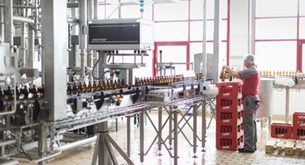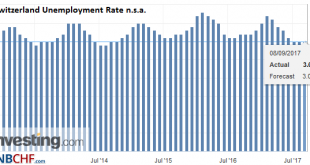In September 2017, the KOF Economic Barometer increases by 1.6 points. It thus partially reverses its previous month’s decline. With a new reading of 105.8, the Barometer still points to a level clearly above its long-term average. This indicates that the outlook remains favourable – the Swiss economy should continue to grow at above average rates in the near future. In September 2017, the KOF Economic...
Read More »Switzerland UBS Consumption Indicator August: A pleasant end to summer
The Swiss consumption indicator by UBS shows improvements. The indicator is still distant from the highs in 2012. At the time stronger growth in Emerging Markets and the weaker franc helped the Swiss economy. The UBS consumption indicator increased to 1.53 points in August thanks to robust new car registrations and encouraging numbers of hotel stays by Swiss residents, indicating consumption growth slightly above the...
Read More »Swiss annual growth forecast takes a cut
Manufacturing has picked up, but not overall growth. (Keystone) Swiss economic growth estimates for the year have been revised down to under 1% by the State Secretariat for Economic Affairs (SECO). This would make it the slowest year since 2009. The stats released Thursday predict a growth rate of 0.9% for 2017. The figure has fallen from previous estimates of 1.4%, and would mark the worst-performing economic year...
Read More »Swiss economy resumes stronger growth
Economic forecasts by the Federal Government’s Expert Group – autumn 2017* – Because of the weak performance in the first half of the year, the Federal Government’s Expert Group anticipates only moderate GDP growth of 0.9% in 2017. Over the coming quarters, though, solid momentum in the global economy is set to support the export sector, while the domestic sector is also expected to gather pace. Sizeable GDP growth of...
Read More »Swiss Trade Balance August 2017: Dynamism of Imports
We do not like Purchasing Power or Real Effective Exchange Rate (REER) as measurement for currencies. For us, the trade balance decides if a currency is overvalued. Only the trade balance can express productivity gains, while the REER assumes constant productivity in comparison to trade partners. Who has read Michael Pettis, knows that a rising trade surplus may also be caused by a higher savings rate while the trade...
Read More »Swiss Producer and Import Price Index in August 2017: +0.6 YoY, +0.3 MoM
The Producer Price Index (PPI) or officially named “Producer and Import Price Index” describes the changes in prices for producers and importers. For us it is interesting because it is used in the formula for the Real Effective Exchange Rate. When producers and importers profit on lower price changes when compared to other countries, then the Swiss Franc reduces its overvaluation. The Swiss PPI values of -6% in 2015...
Read More »Swiss Real Estate: The Empty Dwellings Rate Continues to Increase
The Swiss Real Estate Bubble and Rents The number of empty dwellings is an important indicator for the Swiss real estate bubble. Prices of Swiss real estate had risen by 5%-8% per year between 2009 and 2014, while rents for existing contracts are regulated and have not followed this path yet. Landlords can only introduce higher prices levels for new buildings or new contracts. The reader should bear in mind that the...
Read More »Switzerland Unemployment in August 2017: Unemployment Slightly Falling
Unemployment Rate (not seasonally adjusted) Bern, 08.09.2017 – Registered unemployment in August 2017 – At the end of August 2017 135’578 unemployed persons were registered at the Regional Employment Services Centers (RAV), according to the SECO (State Secretariat for Economic Affairs), 1’652 more than in the previous month. The unemployment rate remained at 3.0% in the reporting month. Compared to the previous month,...
Read More »Switzerland Q2 GDP: +0.3 percent QoQ
Switzerland’s real gross domestic product (GDP) grew by 0.3 % in the 2nd quarter of 2017. Manufacturing, the financial sector and the hotel and catering in-dustry significantly boosted growth, while developments in trade, public administration and the healthcare sector were sluggish. On the expenditure side, growth was driven by domestic demand, with positive momentum coming from both consumption and investment. By...
Read More »Switzerland Q2 GDP: +0.3 percent QoQ
Switzerland’s real gross domestic product (GDP) grew by 0.3 % in the 2nd quarter of 2017. Manufacturing, the financial sector and the hotel and catering in-dustry significantly boosted growth, while developments in trade, public administration and the healthcare sector were sluggish. On the expenditure side, growth was driven by domestic demand, with positive momentum coming from both consumption and investment. By...
Read More » Swiss Economicblogs.org
Swiss Economicblogs.org









